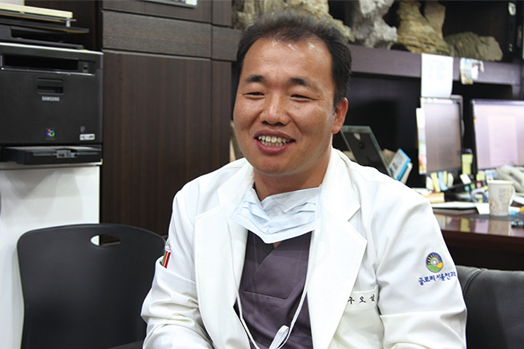|

Dr. GU Oh-Seop
I want to know the concept of presbyopia and cataract and
the types of treatment.
Presbyopiais the most common change in eye as one gets older. Put it simply, crystalline lens distinguishes close objects from distant ones, and if this lens loses its control, it causes this disease. People who are near-sighted or far-sighted usually get Laser Blended Vision (LBV) LASIK or LASEK surgery to treat their aged eye as way to correct their vision and those who do not see close objects well despite the absence of nearsightedness orfarsightedness receive a corneal inlay rather than LBV surgery. Furthermore, presbyopia mostly comes from the 40ties and in the 50ties, cataract occurs with the aged eye. At this time, they usually receive mainly multi-focal intraocular lens (IOL) insertion among others.
I’d like to know the laser multi-focal intraocular lens insertion
in more detail.
To knowthe laser multi-focal intraocular lens insertion, it is better to understand the history of cataract operation in terms of development. Cataract operation has developed a lot compared to in the past. The cataract operation in its early days was literally at the level of removing the cataract only. If the cataract is removed, refraction occurs. In this case, patients had to use largely thick longdistance glasses. However, due to thick glasses and severe distortion of image, a small lens in eye was made. This is called as intraocular lens. The initial intraocular lens had only one focus. Distant objects were seen, but to see close objects, one had to wear glasses. This was a big disadvantage. Patients gradually had a stronger desire for seeing close objects as well as distant ones without glasses and to satisfy their needs, multi-focal intraocular lens insertion was developed. It means that cataract operation made it possible to improve (or cure?) nearsightedness, farsightedness, presbyopia and even astigmatism not to mention to remove cataracts.
Is cataract a congenital disease?
Cataract is a senile disorder. Just as one begins to wrinkle with age, it is common that crystalline lens becomes aged. However, congenital cataract may also occur. Humans don’t have eyesight of 1.0, congenitally. Eyesight is gradually developed through training to see objects until about 10 years old since birth. Congenital cataract disease may be at a risk of leading to amblyopia because it is a factor to inhibit eyesight development. Congenital cataract is probabilistically low, but a disease that can be occurred in young children. Soit is important to discover it in advance and receive treatment.
I want to know the difference between cataract and glaucoma.
Cataract and glaucoma are totally different. Cataract literally means clouding of the lens. It may occur in almost all people in a greater or less degree. Just as a certain blood pressure flows in our body, there is an intraocular pressure in our eye, which helps to maintain a certain pressure. If intraocular pressure is higher than the base value, optic nerves of an eye play a less role, become near-sighted, and finally go blind. This is called as glaucoma. Furthermore, glaucoma has genetic predisposition and if glaucoma is definitely diagnosed, it is difficult to be recovered, in most cases. Regular inspection is required.
I f you have your own advantages as hospital, can you tell me about them?
In the first place, what is considered as the most important in our hospital is eye examination. Unlike in other hospitals, we are operating our online website for eye examination. Second, our hospital is specialized in cataract disease compared to other hospitals. Our medical staff are competent in three fields of cornea, crystalline lens, and retina in the entire process of diagnosing, inspecting, and operating. As we hold high-tech equipment Catalys, developed by Abbot, U.S., we can provide patients with a safe and accurate procedure.
Which countries are visiting your hospital from overseas and
what procedure they want to receive quite often?
Many people came from the North America regions European regions etc, and they had a various background With the recent increase in medical tour, more patients from Southeast Asia, Russia, Mongolia, and China are visiting. We passivelytreated domestic patients in the past and largely performed simple sight correction a lot, but presbyopia operation, especially laser multi-focal intraocular lens surgery, among the cataract operations, is gradually increasing these days.
What kinds of service do you provide for patients coming from overseas?
Our hospital is introducing outcome-optimized procedures based on precision diagnosis for eye health and anti-aging.
Within the hospital, consulting and treatment in English are available and our responses are immediately provided for inquirers anywhere from overseas. By providing care service after surgery, we can provide patients coming from overseas with medical consultation no matter when and where they are based upon results of eye exams they received.
Please tell me about your hospital’s strategy and goals.
Glory Seoul Ophthalmology is doing the best to become the world’s ophthalmic clinic patientsfrom countries around the world can visit rather than being just Korea’s own clinic.
We are developing English web sites, marketing data, and new contents that can meet global needs.
Moreover, we are contributing toclear sight recovery for many people who will receive cataract operation and planning to provide those who can’t afford to receive operation although they have to receive it with medical services. Our specialized area, cataract operation contributes continuously to the clear sight recovery for many people.

|

